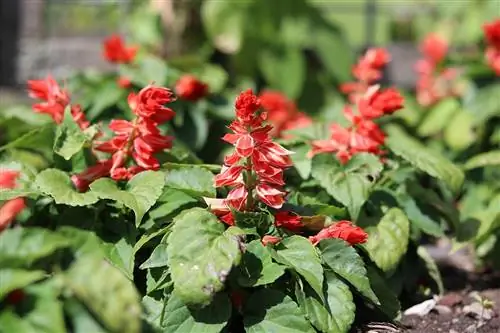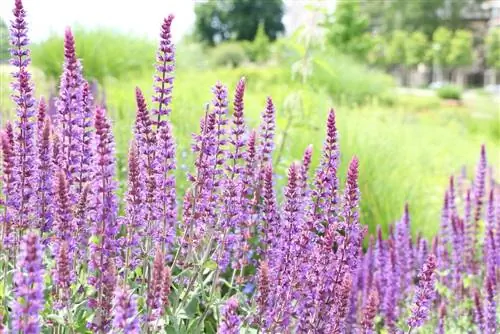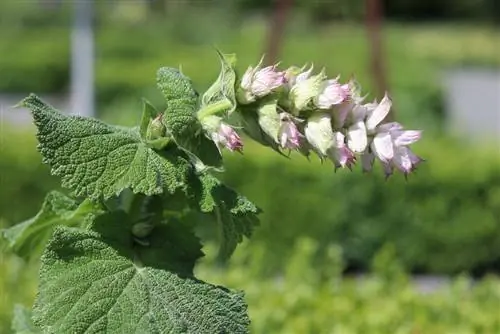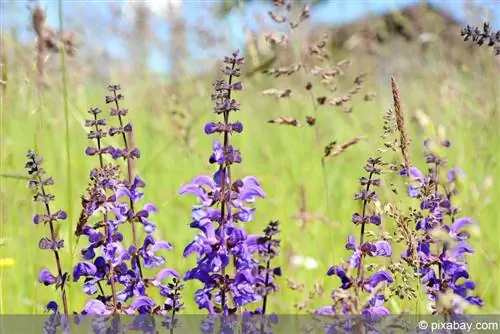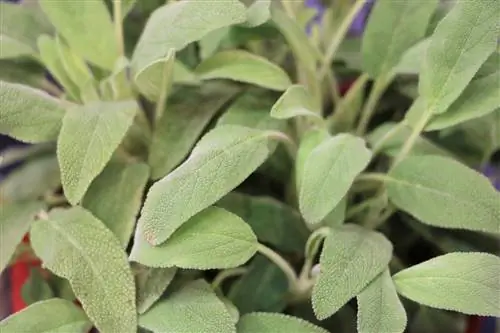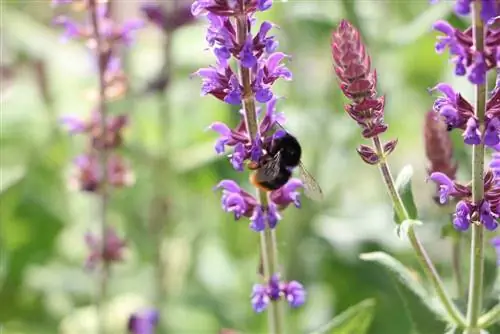- Author admin [email protected].
- Public 2023-12-17 03:39.
- Last modified 2025-01-24 12:45.
The fire sage impresses with its bright colors and panicle-shaped flowers, but also requires the appropriate care and factors. We show what matters.
Profile
- comes from Brazil
- average 20 to 30 centimeters high
- panicle-shaped flowers
- available in different colors
- Growth habit is compact
Location
The fire sage needs a sunny, protected location. Although it also thrives in partial shade or shade, it does not then reach its full flowering potential. The flower color can also be paler.
It is also important to have protection against:
- Hail
- heavy rain
- Wind
South and east sides, close to a house wall, wall or fence, are ideal. Larger plants that don't provide too much shade but can absorb strong winds can also be useful.
Substrate
Choosing the substrate for Salvia splendens is extremely easy, as normal potting soil or fresh garden soil is sufficient. The substrate should still meet some requirements. Below:
- good water storage
- no tendency to compaction and waterlogging
- loose consistency
- moderate nutrient content
Note:
If the plant or garden soil is very dense, it may be necessary to loosen the substrate with sand or coconut fiber. Foreign bodies such as roots and stones should also be removed.
Pouring
Salvias do not need a lot of water, but are sensitive to waterlogging. This means that the substrate can be kept slightly moist at all times, but drying out can be tolerated without any problems, at least for a short time.
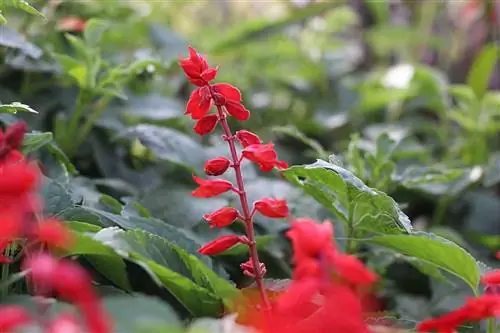
Tip:
In order to avoid waterlogging, it is advisable to add a drainage layer to the planter. Coarse gravel or shards of clay at the bottom of the pot or bucket are ideal.
Fertilize
Fire sage does not require large amounts of nutrients, but regular fertilization can increase flowering power. It is therefore advisable to supply nutrients, especially for multi-year cultivation in the bucket.
A simple fertilizer for flowering plants is suitable. This should be added to the irrigation water once a week, but no more than half a dose.
Blend
A blend is not absolutely necessary with Salvia splendens, but it does have some advantages. Offcuts are recommended in the following cases:
- immediately after the flowers wither
- for damaged plant parts
- during the new shoots in spring
By directly removing the dried flowers, another flowering phase can be stimulated. However, cutting off wilted or otherwise damaged plant parts reduces susceptibility to pests and diseases. A trimming during budding ensures that the plant grows particularly dense and voluminous.
Propagation by seeds
Propagation via seeds is extremely easy for salvias. The seeds can be sown or brought forward as early as February. The following steps are useful for this:
Choose substrate
Planting soil, herb soil or a simple standard soil are completely sufficient for germination. The substrate should be slightly moist but not wet.
Sowing
The seeds are pressed lightly into the soil at a distance of about five centimeters. It is then sufficient to cover the seeds with a layer of approximately three millimeters of substrate.
Humidification
For moistening, the soil can be carefully watered or sprayed with low-lime water.
Location
A bright location without direct sun is optimal for germination. The temperature should be around 20 degrees Celsius.
Cover
A glass plate, a transparent film or an indoor greenhouse keeps the soil slightly moist without frequent watering and promotes germination. However, the chosen cover should be ventilated daily to avoid the formation of mold.
The first shoots should be visible after about one to two weeks. When these are about five centimeters high, pricking can take place. The plants are removed individually and placed in larger containers. Particularly weakly growing Salvia can be removed directly.
Tip:
Heating the substrate to at least 100 degrees Celsius in an oven or microwave ensures that germs, such as fungal spores, are killed. Pests also have no chance thanks to the heat treatment.
Propagation through shoot tips
Another way to propagate fire sage is to obtain shoot tips. These can be cut off with clean and sharp scissors.
Then they are inserted into potting soil or simple garden soil. This should also be kept slightly moist at all times. The planter must be bright and warm.
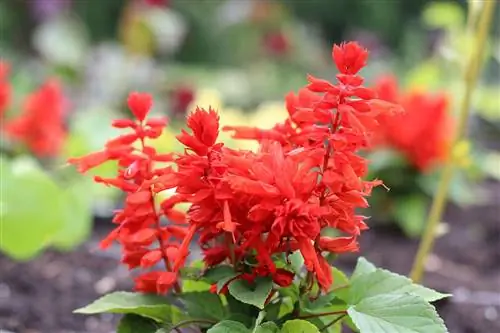
Bucket Culture
Salvia splendens can also be grown wonderfully in a bucket. This has the advantage that the otherwise annual cultivated plant can be overwintered extremely easily and will last for several years. However, a few points must be taken into account in order to keep the plant strong and to avoid diseases and pest infestation.
This includes:
- Introduction of a drainage layer
- more frequent watering
- annual repotting
- safe and secure location
- stable planter
- weekly fertilization
Since the plant has less substrate available, the stores of liquid and nutrients are also lower. At the same time, care must be taken to ensure that no waterlogging occurs.
Tip:
The plant can also be planted outdoors using a planter. This means that more soil is available and wintering can still be done comparatively easily indoors.
Wintering
Although fire sage with its eye-catching flowers is usually only cultivated outdoors for one year, Salvia splendens is a perennial plant. However, it is not hardy.
Nevertheless, overwintering is extremely easy, especially when grown in a pot. All you need to consider are the following factors:
- as bright a location as possible
- Let the upper substrate layer dry thoroughly between waterings
- regular checks for diseases and pests
- Temperatures between five and ten degrees Celsius
You should also make sure that fertilization is stopped in September at the latest. This allows the plant to prepare accordingly for winter rest. Waterlogging must be avoided urgently.
Pests, diseases, care errors
Pests are not to be expected with the flowering sage. However, rot and mold are common, as are other fungi. These are usually due to care errors. These include:
- wrong location
- missing drainage
- dammed water
- inferior soil
- do not remove withered plant parts
- Use of water rich in lime
- watering too frequently
Whenever excessively wilted plant parts occur, the soil smells unpleasant or changes color, the care conditions should be checked carefully. Problems with the plant often arise from deficiencies in the culture and can therefore often be easily remedied.

